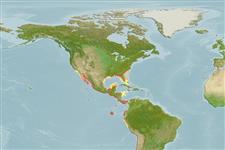Teleostei (teleosts) >
Eupercaria/misc (Various families in series Eupercaria) >
Gerreidae (Mojarras)
Etymology: Eucinostomus: Greek, eu = good + Greek, kyon = dog + Greek, stoma = mouth (Ref. 45335).
More on author: Gill.
Environment: milieu / climate zone / depth range / distribution range
Ecology
Marine; freshwater; brackish; demersal; depth range 1 - 50 m. Subtropical; 35°N - 12°S, 120°W - 75°W
Eastern Pacific: Anaheim Bay, southern California, USA to Peru.
Size / Weight / Age
Maturity: Lm ? range ? - ? cm
Max length : 21.0 cm TL male/unsexed; (Ref. 2850); common length : 12.0 cm TL male/unsexed; (Ref. 55763)
Body fusiform, compressed, and slender (depth contained 3.2 to 3.6 times in standard length); jaws protrusible; edge of preopercle smooth; second anal spine short and thin; pelvic fin short (1.8 to 2.0 times in head length); body silvery, darker in the dorsal region; fins transparent except for tips of dorsal spines which are black (Ref. 55763).
Found over soft bottoms of coastal waters, especially abundant in brackish waters (Ref. 9303). Feeds on crabs and shrimps (Ref. 37955). Depth range assumed (RF).
Life cycle and mating behavior
Maturities | Reproduction | Spawnings | Egg(s) | Fecundities | Larvae
Eschmeyer, W.N., E.S. Herald and H. Hammann, 1983. A field guide to Pacific coast fishes of North America. Boston (MA, USA): Houghton Mifflin Company. xii+336 p. (Ref. 2850)
IUCN Red List Status (Ref. 130435)
Threat to humans
Harmless
Human uses
Fisheries: minor commercial; bait: occasionally
Tools
Special reports
Download XML
Internet sources
Estimates based on models
Preferred temperature (Ref.
123201): 22.3 - 28.1, mean 24.2 °C (based on 274 cells).
Phylogenetic diversity index (Ref.
82804): PD
50 = 0.5010 [Uniqueness, from 0.5 = low to 2.0 = high].
Bayesian length-weight: a=0.01096 (0.00850 - 0.01415), b=3.10 (3.06 - 3.14), in cm total length, based on LWR estimates for this species (Ref.
93245).
Trophic level (Ref.
69278): 3.1 ±0.3 se; based on diet studies.
Resilience (Ref.
120179): High, minimum population doubling time less than 15 months (Preliminary K or Fecundity.).
Fishing Vulnerability (Ref.
59153): Low vulnerability (11 of 100).
Nutrients (Ref.
124155): Calcium = 150 [77, 307] mg/100g; Iron = 1.27 [0.65, 2.39] mg/100g; Protein = 19.3 [17.4, 21.1] %; Omega3 = 0.401 [0.220, 0.723] g/100g; Selenium = 20.8 [10.9, 39.4] μg/100g; VitaminA = 11.9 [3.7, 33.5] μg/100g; Zinc = 1.17 [0.80, 1.67] mg/100g (wet weight);
